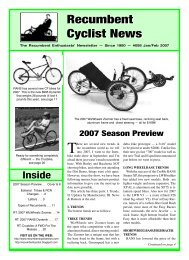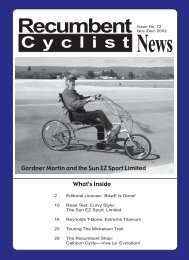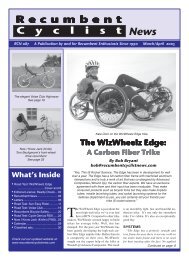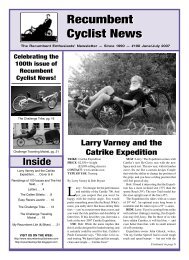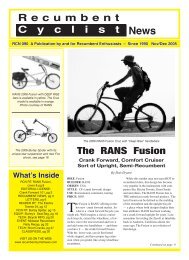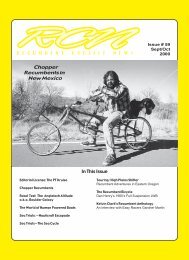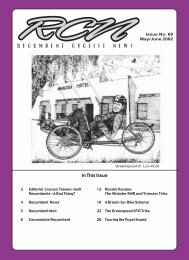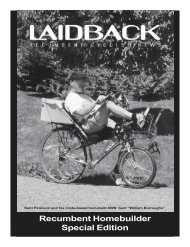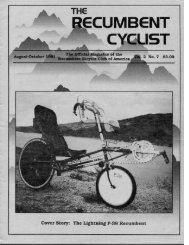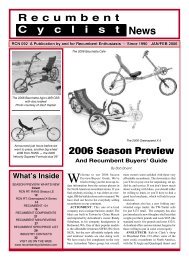Recumbent News
Recumbent News
Recumbent News
You also want an ePaper? Increase the reach of your titles
YUMPU automatically turns print PDFs into web optimized ePapers that Google loves.
Rec-Tech<br />
The TerraCycle<br />
Fold-Forward Stem<br />
Pat Franz is the man behind TerraCycle,<br />
Inc., a recumbent and special-needs bicycle<br />
manufacturer in Portland, Oregon.<br />
He specializes in designing and building<br />
bikes, parts, and accessories that are on<br />
the cutting edge of technology. One of his<br />
special-needs trikes powered a rider to two<br />
silver medals in the 2000 Sydney<br />
Paralympics.<br />
Seeing a need for a different type of<br />
fold-forward stem for above-seat-steering<br />
recumbents, Pat created the GlideFlex.<br />
This completely new design with several<br />
unique features:<br />
• Smooth bending friction, completely<br />
adjustable from negligible to firm<br />
• No metal-to-metal contact in the hinge<br />
or friction system (it’s silent thanks to<br />
Delrin friction bushings)<br />
• Wraparound steerer clamp to keep the<br />
back of the stem smooth<br />
• Available in a range of riser tube lengths<br />
and diameters— standard is 1” OD and<br />
7” long<br />
• Available in a variety of anodized col<br />
ors (or clear anodized)<br />
• Optional quick-release lever can be used<br />
to control friction—an allen-head bolt<br />
is standard<br />
• Adjustable tilt angle<br />
22 <strong>Recumbent</strong> Cyclist <strong>News</strong> 71<br />
by Shari Bernhard<br />
Those are the marketing details. They’re<br />
all true.<br />
Pat requested my assistance in beta testing<br />
a GlideFlex prototype on my V-Rex,<br />
and I happily agreed. Having seen his<br />
work firsthand, I had a feeling that this<br />
was going to be a fine piece of equipment.<br />
I wasn’t disappointed when it arrived a few<br />
days later.<br />
It’s beautifully machined, with the<br />
TerraCycle logo engraved on the side. The<br />
stem comes with excellent, and remarkably<br />
simple, installation instructions, complete<br />
with annotated pictures. Even so, I<br />
didn’t trust myself to install it correctly,<br />
so I enlisted the aid of my mechanic and<br />
friend, Fritz. It took Fritz about three minutes<br />
to look over the instructions and about<br />
five minutes to make the switch. It’s designed<br />
for a threadless headset.<br />
Fritz had some misgivings about the<br />
design. Most notably, instead of a split in<br />
the stem that compresses when the steerer<br />
clamp is tightened, it’s simply squeezed,<br />
which he feared might distort the steerer<br />
tube. He also expressed some concern<br />
about the pivot design, which is comprised<br />
of half the riser tube and half the headset<br />
clamp, with a bolt for the friction control.<br />
It looks like an excellent approach to me,<br />
but then again, I’m no machinist, so I con-<br />
sulted Pat to get his rationale for these<br />
design issues.<br />
Even though it would seem that the<br />
clamp could squeeze the steerer tube and<br />
distort it, the jaws are carefully designed<br />
to exactly match the shape of the tube. It<br />
could be a problem if the shapes didn’t<br />
match, but Pat ensured that the clamping<br />
surface is the same shape as the tube. Additionally,<br />
steerer tubes are fairly thickwalled<br />
CroMoly and not easily distorted.<br />
He tested overclamping, and he was unable<br />
to squish a steerer tube. Pat did his<br />
research. New stems coming on the market<br />
are using the same basic clamping<br />
mechanism. It works well, has a very clean<br />
profile, and virtually eliminates the problem<br />
with clamp arms snapping off.<br />
My first impression is that it’s definitely<br />
sleek looking, and the bending action is<br />
unquestionably smooth and steady, unlike<br />
the sometimes sticky movement of the<br />
original RANS Flip-It stem. It’s only<br />
slightly lighter than the Flip-It, which is<br />
mildly disappointing, and replacing the<br />
pivot friction bolt with a quick-release<br />
skewer eliminates even that difference.<br />
This is not a major issue.<br />
One of Pat’s main design criteria for the<br />
GlideFlex was to make a stem where the<br />
side that faced the rider was smooth, with<br />
nothing sticking out that could catch on<br />
the rider in an accident. This is a solid<br />
improvement over the Flip-It.<br />
After a few rides with the bolt as the<br />
pivot friction mechanism, I requested the<br />
optional quick-release skewer. I thought<br />
it would be more convenient to use a quick<br />
release instead of having to rummage for<br />
my allen wrenches in case I let someone<br />
try out my bike and they preferred a tighter<br />
or looser fit. In Pat’s experience, once the<br />
pivot friction is set to the user’s preference,<br />
it usually isn’t changed. After several<br />
rides with the quick release, I realized<br />
Pat was right—changing the pivot<br />
tension wasn’t necessary after all. I removed<br />
the quick release in favor of the<br />
bolt. It looks more attractive and has a<br />
cleaner profile.<br />
There are two issues that I feel should<br />
be addressed, both involving the tilt. First,<br />
the tilt isn’t as adjustable as it should be<br />
due to the angle machined into the bottom<br />
of the stem riser and its corresponding<br />
surface on the stem clamp. Even with<br />
the backstop bolt screwed in as far as it



